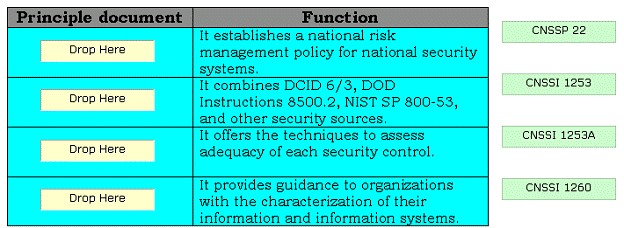Principle Documents for Secure Software Development
Question
DRAG DROP - Drag and drop the appropriate principle documents in front of their respective functions.
Select and Place:
Explanations

The various principle documents of transformation are as follows: CNSSP 22: It establishes a national risk management policy for national security systems.
CNSSI 1199: It creates the technique in which the national security community classifies the information and information systems with regard to confidentiality, integrity, and availability.
CNSSI 1253: It combines DCID 6/3, DOD Instructions 8500.2, NIST SP 800-53, and other security sources into a single cohesive repository of security controls.
CNSSI 1253 A.
It offers the techniques to assess adequacy of each security control.
CNSSI 1260: It provides guidance to organizations with the characterization of their information and information systems.
NIST 800-37, Revision 1: It defines the certification and accreditation (C & A) process.
The NIST 800-37, Revision 1 is a combination of DNI, DoD, and NIST.
As I am an AI language model, I don't have the visual or graphical representation of the question you are referring to. However, based on the description you provided, I can provide you with a general understanding of what the question might be asking and how to approach it.
The question seems to be related to the principle documents that are used in secure software development and their respective functions. The answer might require you to match the principle documents with their corresponding functions by dragging and dropping them in the appropriate places.
Here are some of the principle documents used in secure software development:
Threat model - A document that identifies potential threats and vulnerabilities in a system and outlines strategies to mitigate them.
Security requirements - A document that outlines the security features and functions that should be incorporated into a software application.
Risk management plan - A document that identifies potential risks and outlines strategies to manage them.
Security architecture and design - A document that outlines the security architecture and design of a software application.
Security testing plan - A document that outlines the security testing procedures that should be followed during the development and deployment of a software application.
To match these principle documents with their respective functions, you need to have a basic understanding of the software development lifecycle and the role of each document in that process.
For instance, the threat model is typically used during the design phase of software development to identify potential threats and vulnerabilities. Security requirements are typically used during the requirements gathering phase to specify the security features and functions that should be incorporated into the software application. The risk management plan is typically used during the planning phase to identify potential risks and outline strategies to manage them. The security architecture and design document is typically used during the design phase to outline the security architecture and design of the software application. Finally, the security testing plan is typically used during the testing phase to outline the security testing procedures that should be followed during the development and deployment of the software application.
Based on this understanding, you can drag and drop the principle documents to their corresponding functions, based on their typical usage in the software development lifecycle.
I hope this helps you understand the question better!